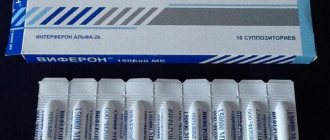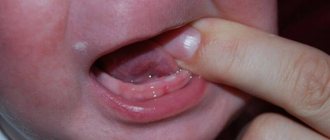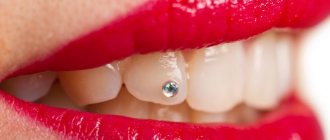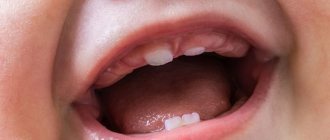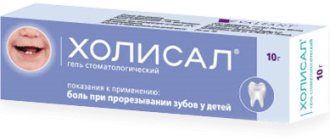Teething is an obligatory process in the life of every child. This period can be completely painless, but in many cases, teething is accompanied by pain and causes discomfort for the child and anxiety for the parents.
Baby teeth emerge from the gum surface at about 6 months of age. During this period, the child may become capricious, eat poorly, and sleep poorly.
Teething is indicated by swollen gums and the production of large amounts of saliva. In more severe cases, a runny nose, cough, diarrhea and vomiting may occur. An increase in temperature to 38⁰ is often observed.
Every mother strives to make the teething process easier for her child. If nothing bothers the baby, then the mother shouldn’t worry, she just needs to watch.
The use of various remedies is necessary only in cases where the child is really unwell - the pain prevents him from eating or sleeping, and the high temperature persists for a long time.
To alleviate the condition of children during teething, rectal suppositories are used, the most popular of which, undoubtedly, are Viburkol suppositories.
Before you start using any remedy, you need to make sure that the child’s painful condition is associated specifically with teething. To do this, you need to visit a pediatrician.
When and in what order do baby teeth emerge?
For most children, the teething pattern looks like this:
- At 6-8 months, two central lower incisors appear.
- At 8-9 months, the upper central incisors.
- At 9-12 months, the upper lateral incisors erupt.
- At 11-12 months, the lower lateral incisors.
- At 12-15 months, the upper and lower molars.
- At 16-18 months, the upper canines
- At 18-20 months, the lower canines.
- Chewing teeth erupt at 2-3 years of age.
During normal development, baby teeth erupt in each area within 2-10 days, and the most unpleasant symptoms usually appear within 2-5 days. All 20 baby teeth erupt by age 3.
What to do if teeth are cut chaotically and behind schedule?
There is no need to sound the alarm right away. In some children, teething begins at 3 months, and in some at 10, and this is not a pathology, but a feature of the body. The same applies to the violation of the order of appearance of the incisors.
But if there is a delay of 3-5 months, you need to go for a consultation with a pediatrician or dentist.
TOP 5 best suppositories
Below are the most popular candles, which, judging by reviews from parents, are the most effective and safe for teething. From the list presented, each mother will be able to choose the appropriate remedy, based on the individual characteristics of the body and the state of the child’s health, as well as the family’s budget.
Cefekon – D: safe if used wisely
The drug is available in the form of suppositories with a dosage of 50, 100 or 250 mg. Used to reduce body temperature and relieve pain.
The main active ingredient is paracetamol. If the temperature is normal, the drug does not affect it, providing only an analgesic effect. Children from 3 months can take the drug.
When teething, Cefekon must be administered into the emptied intestines, after warming up the suppository in the hands. The dosage is calculated as follows: 10-15 mg of the drug per 1 kg of baby’s weight. The effect lasts up to 6 hours.
Cefekon-D has virtually no side effects - in some cases it can cause allergic reactions to its components. If the dose is calculated incorrectly, an overdose may occur and the consequences may be much more severe.
The price of candles (10 pcs.) is 40 - 60 rubles, depending on the dosage.
Pros of suppositories:
- quick effect;
- minimum side effects;
- low price.
Minuses:
- dangerous consequences of overdose;
- There are restrictions on admission.
My daughter’s first teeth have begun to erupt, and her temperature sometimes rises. The child is capricious and cannot sleep. After the administration of Cefekon, she almost immediately calms down and falls asleep.
Nina, 29
Nurofen - on everyone's lips
Children's suppositories are white and small in size. Active substance – ibuprofen, 60 mg per suppository. The drug has analgesic, antipyretic and anti-inflammatory effects.
To reduce fever and relieve pain during teething, 1 suppository is administered rectally. The period between uses of the drug should not be less than 6 hours, the duration of use should not be more than 3 days.
It is not recommended to administer to children weighing less than 6 kg!
Side effects:
- in rare cases – disruption of the hematopoietic process;
- allergic or anaphylactic reaction;
- disorders of the gastrointestinal tract;
- acute renal failure;
- headache.
The price of the product is from 100 to 130 rubles.
Pros:
- small size;
- fast action;
- relatively low price.
Minuses:
- many possible side effects;
- admission restrictions;
- burning sensation upon insertion.
Nurofen in the form of suppositories helped my son a lot during the period when he was teething. On the advice of the doctor, I administered 1 suppository, after which my son fell asleep peacefully and woke up in a great mood. To alleviate the child's condition, one candle per day was used.
Lilya, 21
Viburkol - the most famous, safest
A homeopathic preparation consisting of components of plant origin - chamomile, belladonna, bittersweet nightshade, great plantain, meadow lumbago.
It also contains carbonated lime obtained from oyster shells. Available in the form of white (yellowish-white) suppositories with a slight odor.
Viburkol is used to reduce fever, has an anti-inflammatory effect, and alleviates teething.
To relieve pain caused by teething and normalize body temperature, the drug is administered rectally, one suppository 1-2 times a day (for children under 6 months). After 6 months, suppositories can be placed up to 6 times a day, depending on the child’s condition.
As a side effect, an allergic reaction and, in rare cases, diarrhea may occur.
The price of suppositories (12 pcs.) is from 350 to 510 rubles.
Pros of candles:
- effectively relieves teething symptoms;
- vegetable origin of components;
- minimum side effects.
Minuses:
- high price;
- size.
My daughter cut her first teeth without pain, but with the next ones the calm ended - she cried constantly, slept poorly, and had a fever. On the recommendation of the pediatrician, she put on a Viburkol suppository, a few hours later another one, after which the child calmly fell asleep.
At night I administered the drug again, thanks to which we all managed to get some sleep.
Alina, 31
Panadol, aka paracetamol in a different form
Candles are white (almost white) in color, cone-shaped. Active ingredient: paracetamol, 125 mg in one suppository. Panadol is used as an antipyretic and analgesic.
The medication can be used in children from 6 months of age. The approximate dose of the drug is calculated based on the child’s weight - 10-15 mg per 1 kg. Candles are placed no more than 6 times a day.
Side effects:
- allergic reactions;
- disruption of the hematopoietic process;
- liver dysfunction;
- bronchospasm;
- vomiting, nausea.
Under no circumstances should you exceed the prescribed dose of the drug!
The price for children's Panadol (10 pcs.) is from 55 rubles.
Pros:
- long-term effect;
- convenient shape and size;
- low price.
Minuses:
- many side effects;
- There are restrictions on admission.
When my child was teething, the temperature rose to almost 40⁰. I bought Panadol syrup and suppositories. The syrup started vomiting, but the suppositories very quickly dealt with the high temperature.
Karina, 34
Viferon will relieve fever and strengthen the immune system
Suppositories are white-yellow (yellow) in color. The active substance is human interferon. In addition to it, the drug contains ascorbic acid, sodium carbonate, tocopherol acetate, polysorbate, cocoa butter, and confectionery fat.
The drug is an immunomodulator. During teething, Viferon is used to strengthen weakened immunity and prevent infections. The drug should be taken 1-2 times a day (every 12 hours).
In rare cases, an allergic reaction (itching, rash, irritation) may occur as a side effect.
Price for Viferon 150,000 IU (10 pcs.) – 245-300 rubles.
Pros:
- prevention of infections;
- strengthening the immune system.
Cons: high price.
A child (5 months old) fell ill - the temperature rose and snot appeared. At the pediatrician's appointment, it turned out that we were teething. The doctor prescribed Viferon. After the first suppository, the child’s temperature subsided and he began to feel much better.
Tom, 24
What are the common teething symptoms and what do you recommend?
- Profuse salivation.
One of the most obvious signs is when drool is literally flowing in a stream. Moreover, the symptom may appear a couple of months before the start of eruption.
Saliva should be carefully wiped away as it appears damp towel or napkin so as not to damage the skin. It is best to use wipes that contain xylitol - it prevents the growth of bacteria and the appearance of rashes on the skin.
- A strong desire to put everything in the mouth and chew.
Chewing helps your baby relieve the itching. The main thing is to hide objects that he could accidentally swallow or injure himself.
Lifehack. Bend your index finger and gently insert it into your baby's mouth. If he starts squeezing it with his gums, it means teeth are definitely coming out. If it just sucks, then it’s something else.
- Skin rashes.
A small rash on the cheeks or chin may occur due to skin contact with saliva. On irritated skin you just need to apply baby moisturizer.
ATTENTION! If the rash around the mouth appears without other symptoms of teething, it is better to show the child to the pediatrician!
- The baby cannot suckle normally.
At the peak of feeding, he abandons her and begins to act up. And sometimes he can bite with his gums. In such a situation, there is no need to force the child to eat. Even if he misses 2-3 feedings, nothing bad will happen. When he gets really hungry, he will still take the breast or bottle and eat. If you have no appetite for more than 24 hours, call a doctor.
- Redness and swelling of the gums.
It begins 2-5 days before teeth appear, goes away on its own, you don’t need to do anything.
You can also notice a blue bubble on the gum. This is a eruption hematoma. It occurs as a result of the destruction of small vessels in the gums during tooth eruption. It does not require any specific treatment. It will soon resolve on its own.
Symptoms of teething in a baby
With this physiological process, you may notice symptoms in your baby such as:
- Inflammation and swelling of the gums.
- Hypersalivation. Hypersalivation is an increase in salivation.
- Decreased appetite. This is due to pain in the gum area.
- Sleep disturbance, crying at night, moodiness. All these symptoms are inextricably linked with the accompanying pain syndrome during teething. Our article will help you figure out how to help your baby fall asleep.
- Developing the habit of putting everything in your mouth. This is associated with itching and discomfort in the gum area.
- Increased body temperature. In some cases, the temperature may rise within 37.2-37.5 degrees.
Based on these symptoms, you can understand that the child is teething.
What are the complications, and when to see a doctor?
| Symptom | Teeth are being cut, there is no need to go to the pediatrician | The disease develops, contact your pediatrician |
| Cough | A coughing attack begins due to excess salivation. The cough is wet and infrequent. | The cough gets worse, does not go away, does not allow the baby to sleep, and prevents him from eating. Doesn't stop for more than 2 days. Breathe heavily. |
| Nasal discharge | Nasal discharge is transparent and watery and disappears by the 4th day. | The runny nose does not go away for the 4th day. Lots of yellow or green discharge. |
| Heat | The temperature does not exceed 38 °C and lasts no more than 2-3 days. Rapidly decreases under the influence of antipyretics. | Fever above 38.5 °C for more than 2 days. Signs of a cold appear (severe cough and runny nose). |
| Loose stools | Lasts less than 72 hours. | Lasts more than 72 hours. |
| Changes in the oral cavity | The gums become swollen and red. | The oral mucosa is covered with white plaque or ulcers. |
The drug Viferon: reviews and studies
Let us say right away that the treatment of viral and bacterial diseases with interferons is recognized in the USA and Europe, and even in Kazakhstan, which is close to us, as ineffective. Clinical studies that were published in Russia have a level of evidence – class II (B). This means that small randomized controlled clinical trials were conducted, involving only a small number of people. From the point of view of evidence-based medicine, such studies do not inspire much confidence. Nevertheless, sales of Viferon are a very large market of several billion rubles.
As a doctor (my personal opinion), I do not consider the drug Viferon to be effective, and I have never seen a significant positive result from its mono use. As for patients, patient reviews of Viferon are absolutely diverse, because... Patients usually take several medications at once. Therefore, it is easy to make a mistake in interpreting the results, because the result could have been achieved through another drug, or simply through the natural cessation of the disease. This is well demonstrated by the proverb: To treat a cold or not to treat it, it will still go away in 7 days.
What can be done to help a child with severe itching and pain?
- Carry your baby in your arms more often, play with him and distract him.
- Give chilled water in a bottle, cool fruit puree or kefir. The main thing is that the liquid is not too cold, otherwise the baby will catch a cold.
- Massage the gums with a special silicone brush (see picture above) or you can gently use your clean finger.
- Buy your baby a teether and let's chew.
Such devices are made from plastic, rubber, silicone, wood, or a combination of different materials. The surface of the toys should be elastic and uneven to make it easier for the child to scratch the gums. A cooled teether relieves itching better, so it can be placed in the refrigerator to cool for 10-15 minutes. But don't chill it in the freezer!
- Do not use gum gels with lidocaine and benzocaine.
The child has a lot of saliva in the mouth, so gels are not effective during this period. The child swallows most of the gel.
Pros and cons of suppositories
Rectal suppositories have the following advantages:
- complete absorption - it is difficult for a small child to administer the medicine orally, therefore most of it may simply not enter the body;
- fast action - suppositories are absorbed by the intestinal walls and enter the bloodstream faster, as a result of which the effect occurs within a short time;
- minimal load on the gastrointestinal tract and liver.
There are also disadvantages:
- discomfort when inserting a suppository;
- the possibility of injury to the skin of the anus if inserted incorrectly;
- irritation of the rectal mucosa.
What should you not do when your baby is teething?
- Strongly touch the child’s gums with your fingers, press on them and pick them out. This can increase pain or cause infection.
- Conduct vaccination, because immune system is weakened during this period .
- Without supervision, allow your child to chew any hard foods that could cause choking.
- Give homeopathic remedies. Not only will they not help the child, but they can cause serious harm.
The eruption of baby teeth is not a problem, but a natural process for a child’s body. But if you are not sure about something, do not hesitate to ask specialists. If you have any questions, write to us on Instagram.
Indications and contraindications
When the first teeth erupt, the baby may begin to be capricious. The child experiences sleep disturbances, refuses to eat, body temperature rises, and the baby experiences pain. Such symptoms can be observed in many diseases, this is the reason to make sure that the symptoms appear due to the growth of teeth.
As soon as the baby pulls everything into the oral cavity, parents need to examine the mouth and gums. If the gum is inflamed and there is a whitish lump on it, then this indicates only one thing. The child’s pain will go away after the tooth passes through the bone tissue and gums.
It can take some time. To eliminate discomfort, you can resort to medication.
If the baby is correctly identified as feeling unwell, suppositories have no contraindications. Of course, if the baby is not allergic to the components included in the product.
In pharmacology, there are 2 types of drugs that can help with tooth growth:
- local painkiller, these are gels or ointments;
- anesthetics that are taken orally.
A suppository is considered one of the safe and effective medications. It is recommended to resort to his help as a last resort, when the child can no longer endure the pain, and the pediatrician prescribes their appointment. You should not self-medicate; it is better to consult your pediatrician.
For pain, children are prescribed medications that can have a mild effect. The age of the child also becomes a criterion when choosing medications. For infants, suppositories are prescribed, for older children - suspensions.
Eruption of molars
The eruption of molars in children is somewhat different. Already “adult” teeth do not cause such intense symptoms. This may be due to the fact that the child’s pain threshold has already increased significantly. Another advantage is that the permanent tooth erupts through the gum, which has not yet completely healed after the baby tooth has fallen out.
The process of replacing baby teeth with permanent ones occurs at the age of 5–7 years. This happens as follows. The rudiments of molars begin to form inside the gums and gradually “push” the milk teeth, the roots of which by this time are already resolving. When temporary crowns fall out, they are replaced with permanent ones.
The pattern of eruption of permanent teeth in children corresponds to the order of growth and loss of baby teeth. The first teeth to fall out are the central incisors, the lateral incisors, and then the molars. Possible deviation from the norm. The correspondence between the eruption of primary and permanent teeth is explained by the “life” of the roots of the first teeth. The bite changes completely only at 10–14 years of age. By this age, the child should have 28 teeth. The remaining 4 are eights (wisdom teeth) and they all grow individually.
Viferon ointment: instructions for use
Viferon ointment can be used in adults and children from 1 year of age to treat herpetic infections localized on the skin or red border of the lips (for the mucous membrane it is better to use Viferon gel). For herpetic rashes, the ointment is applied in a thin layer to the affected areas 3-5 times a day. The duration of treatment is only 5-7 days. Viferon ointment can be used without restrictions during pregnancy and breastfeeding. Viferon ointment – price starts from 180 rubles. We hope you found our article useful!
Sources:
1. The author’s higher professional education in dentistry, 2. Based on 20 years of personal experience as a dentist, 3. The European Academy of Paediatric Dentistry (EU), 4. National Library of Medicine (USA), 5. https://www. vidal.ru/, 6. “Pediatric therapeutic dentistry. National leadership" (Leontyev V.K.).
Viferon gel: instructions, price
Viferon gel is used (as well as suppositories) for the treatment of acute and recurrent herpetic stomatitis. The gel is applied 4-5 times a day directly to the lesions on the oral mucosa (24stoma.ru). Before applying the gel, it is advisable to dry the mucous membrane with a dry gauze swab, then apply the gel to the lesions using a spatula or a cotton swab. The course of treatment is from 5 to 10 days (until symptoms disappear).
Viferon gel is also suitable for treating not only the mucous membrane, but also the red border of the lips. The drug can be used by pregnant and lactating women without any restrictions (due to the low absorption of the active ingredients through the mucous membrane). Viferon gel – the price will be 0t 150 rubles.
Ointment and gel - rules of use
Ointment or gel is often used to treat herpes on the skin and mucous membranes. A single dosage is 0.5 cm. The drug is applied to the skin or mucous membrane (nasal passages, tonsils) 3-5 times a day. The surfaces to be treated must be pre-cleaned. The duration of therapy is 5 days. External agents are indicated simultaneously with Viferon suppositories.
The gel can be used to treat inflammatory processes of the cervix. The product is applied twice a day. Before use, it is recommended to clean the cervical mucosa with a cotton swab so that there is no mucus. The course of therapy is 1-2 weeks. The gel is also used as part of the general treatment of cervicitis.
Attention! The tube should be stored in a cool place. Otherwise, the effectiveness of treatment is reduced.
For preventive purposes, external forms are recommended to be applied to the tonsils or nasal mucosa twice a day. Course therapy lasts up to 1 month.
Gel Viferon 36,000 ME
Dosage
Candles will help your child get rid of pain and fever.
Homeopathic medicines can be used for 14 days. However, even homeopathy should be prescribed by a doctor, not an inexperienced parent.
In some cases, pediatricians prescribe the listed suppositories to children whose age has not yet reached 3 months. The treatment of each baby requires an individual approach, but such an important decision should be made by a specialist in the field of pediatrics whether to prescribe suppositories to a newborn or not.
In cases where a 2-month-old baby is teething and severe pain brings agony, the doctor may prescribe a fourth of the suppository every 6-7 hours . This will relieve pain and improve your well-being. Older children are prescribed 1 suppository every 6-7 hours.
In the case when the child’s body temperature reaches 39-40 degrees and does not decrease for a long period of time, and the pain causes irritability and moodiness, the pediatrician may recommend putting suppositories every 30 minutes for a couple of hours. Next, a break must be observed (about 12-14 hours).
Important! You can put no more than 4 candles per day!
